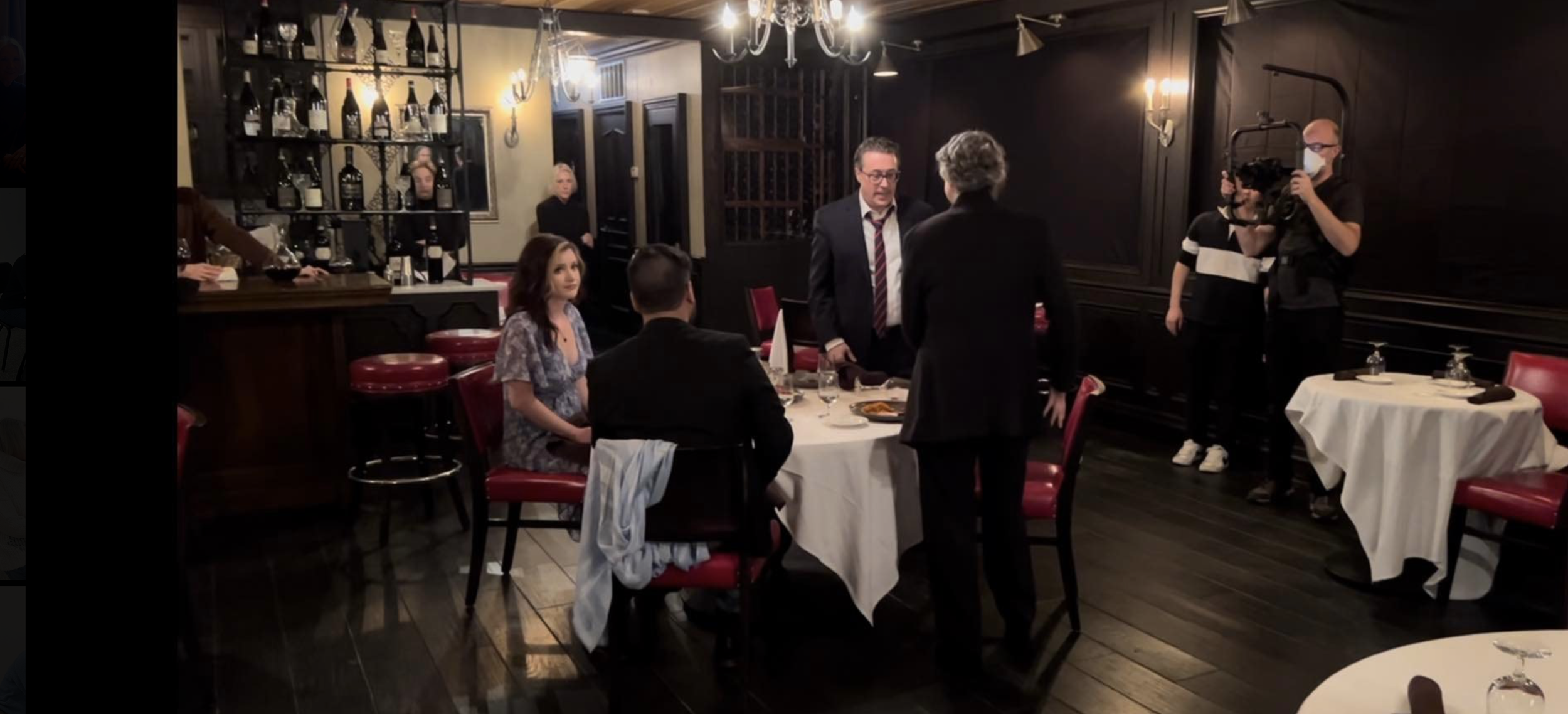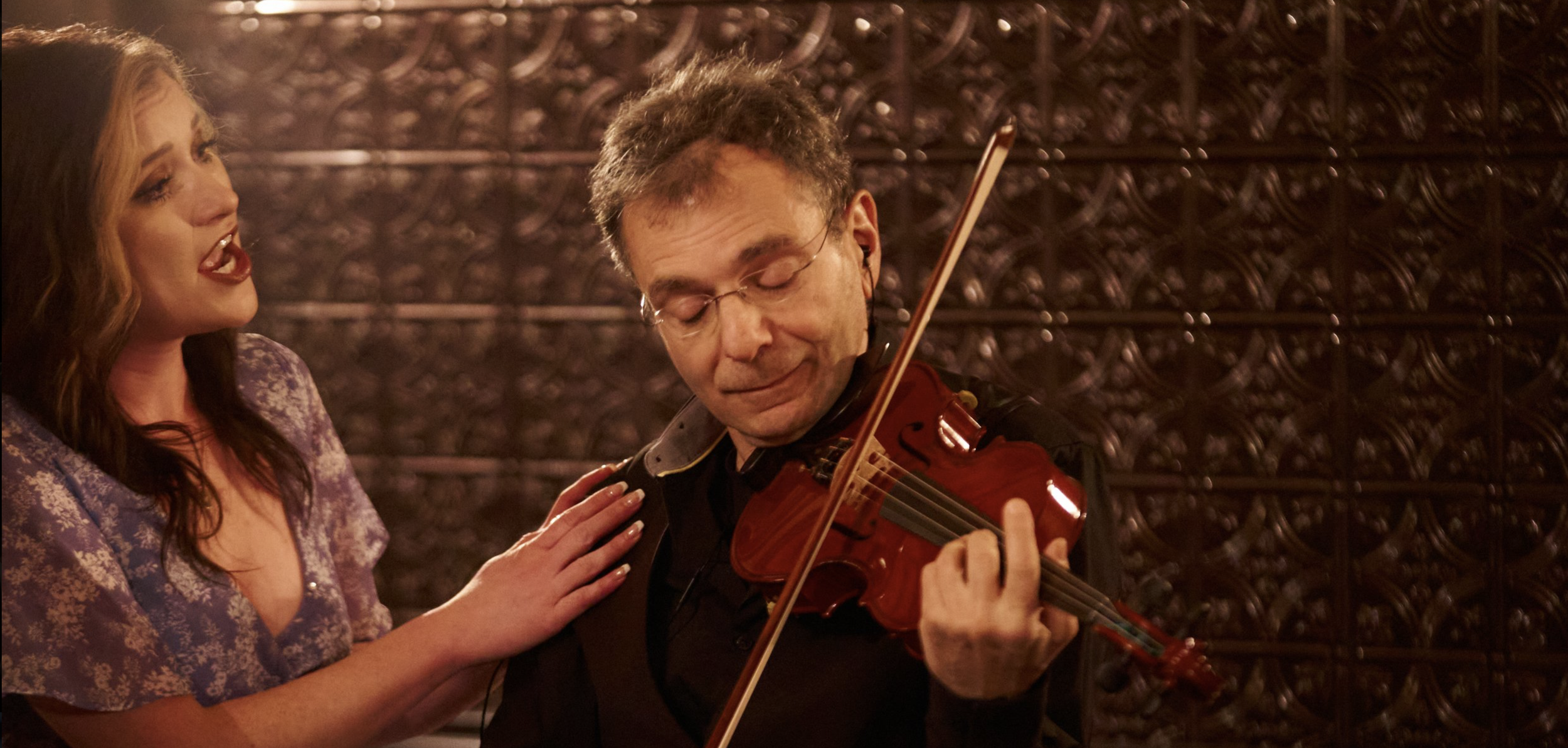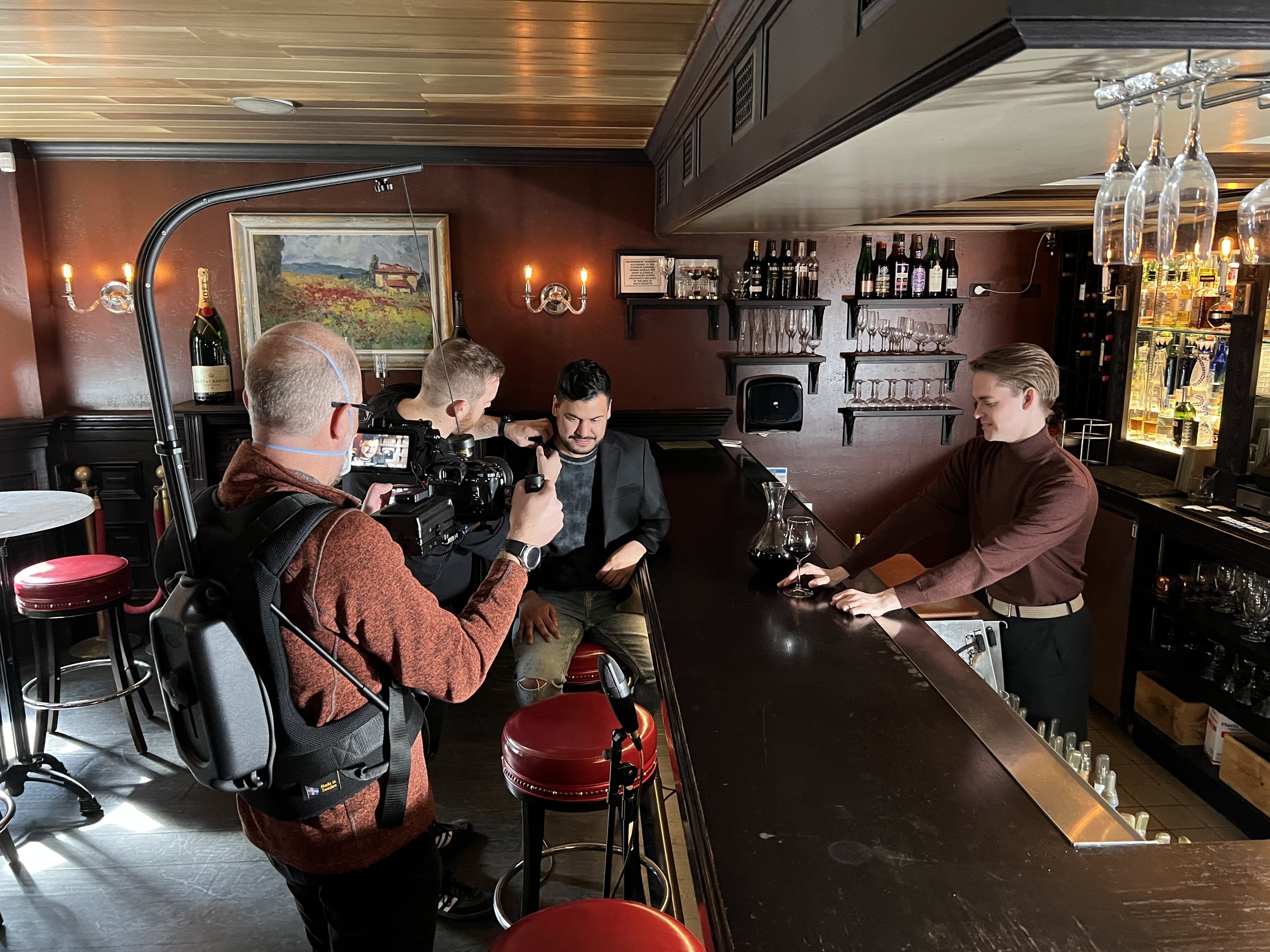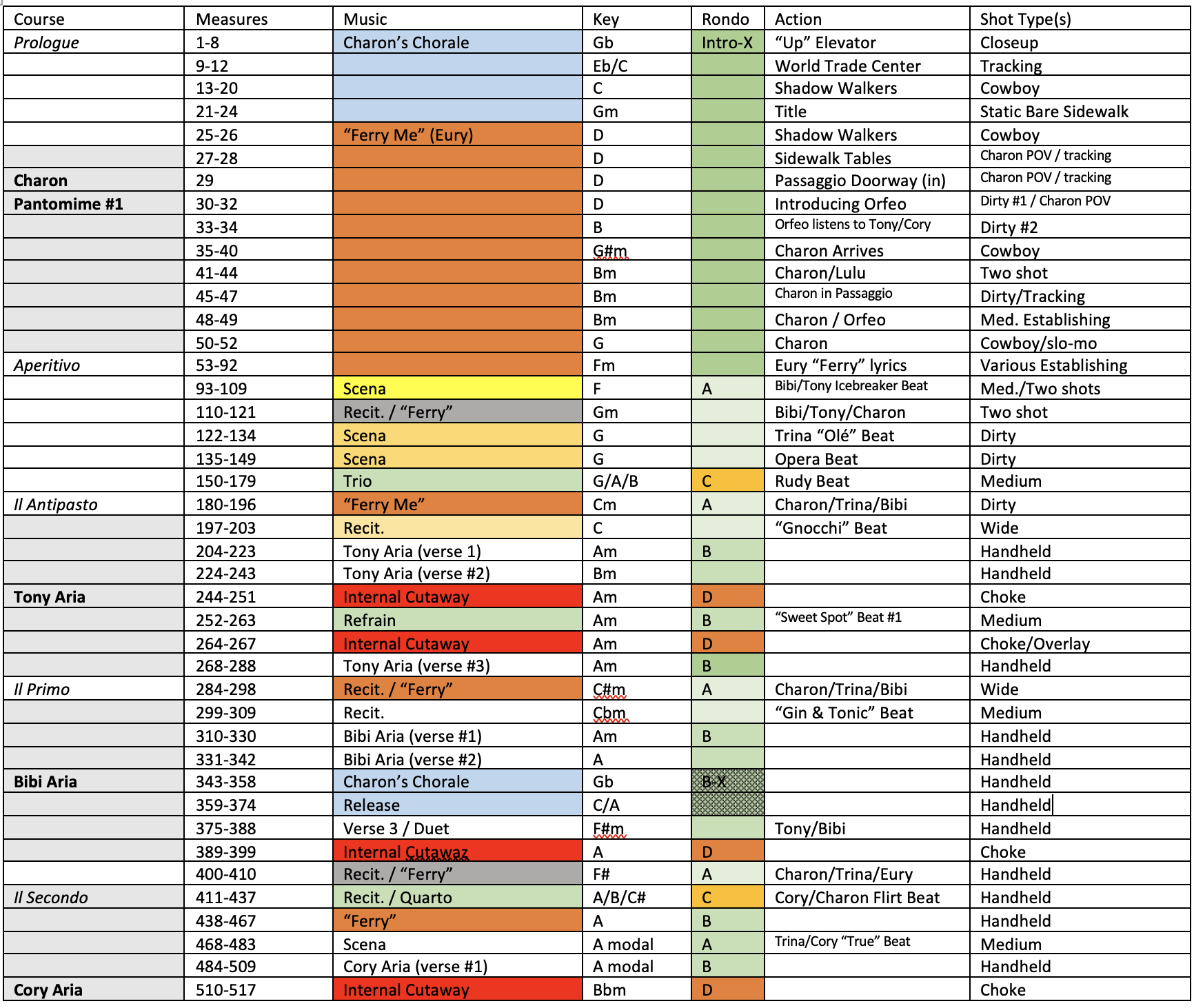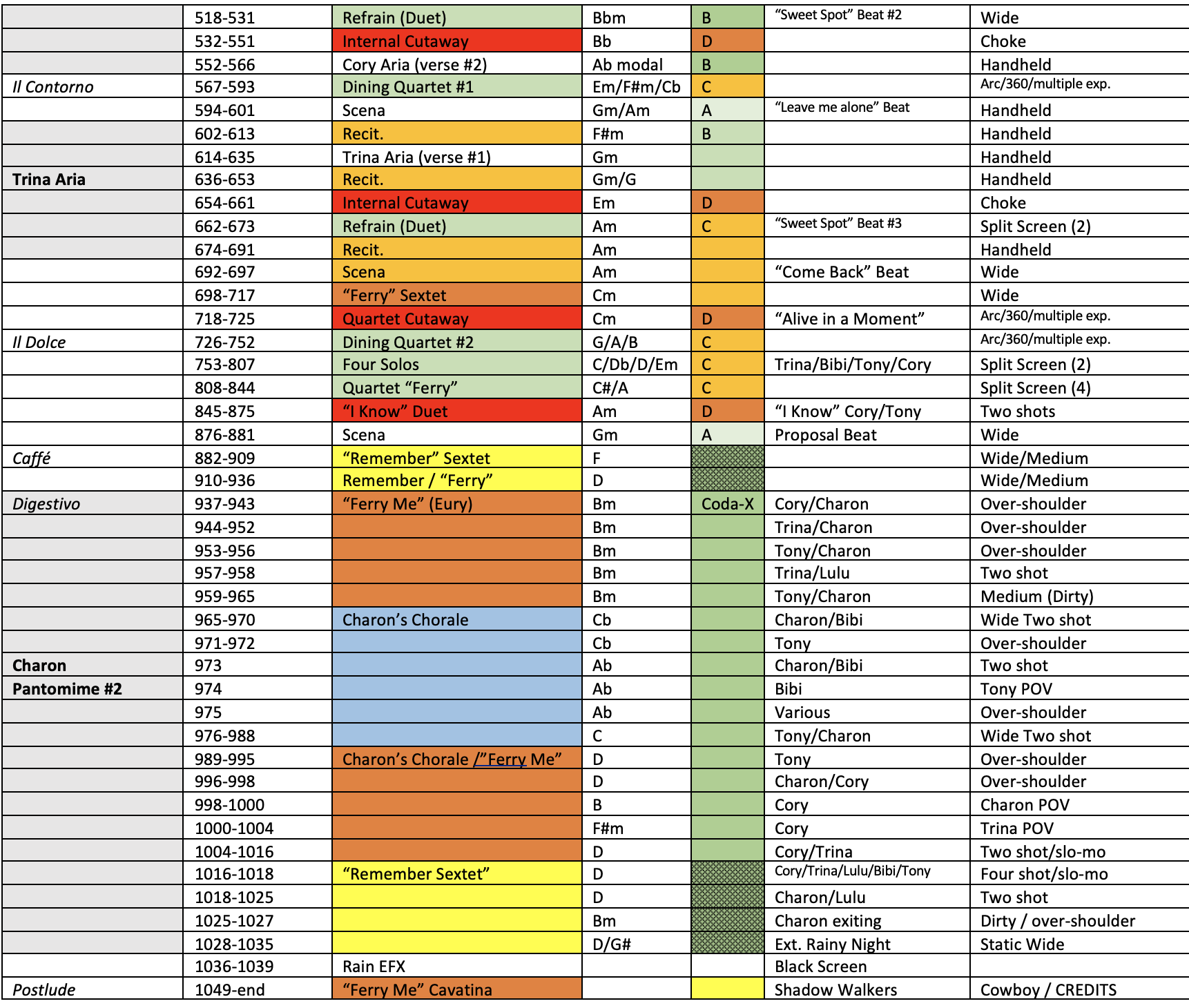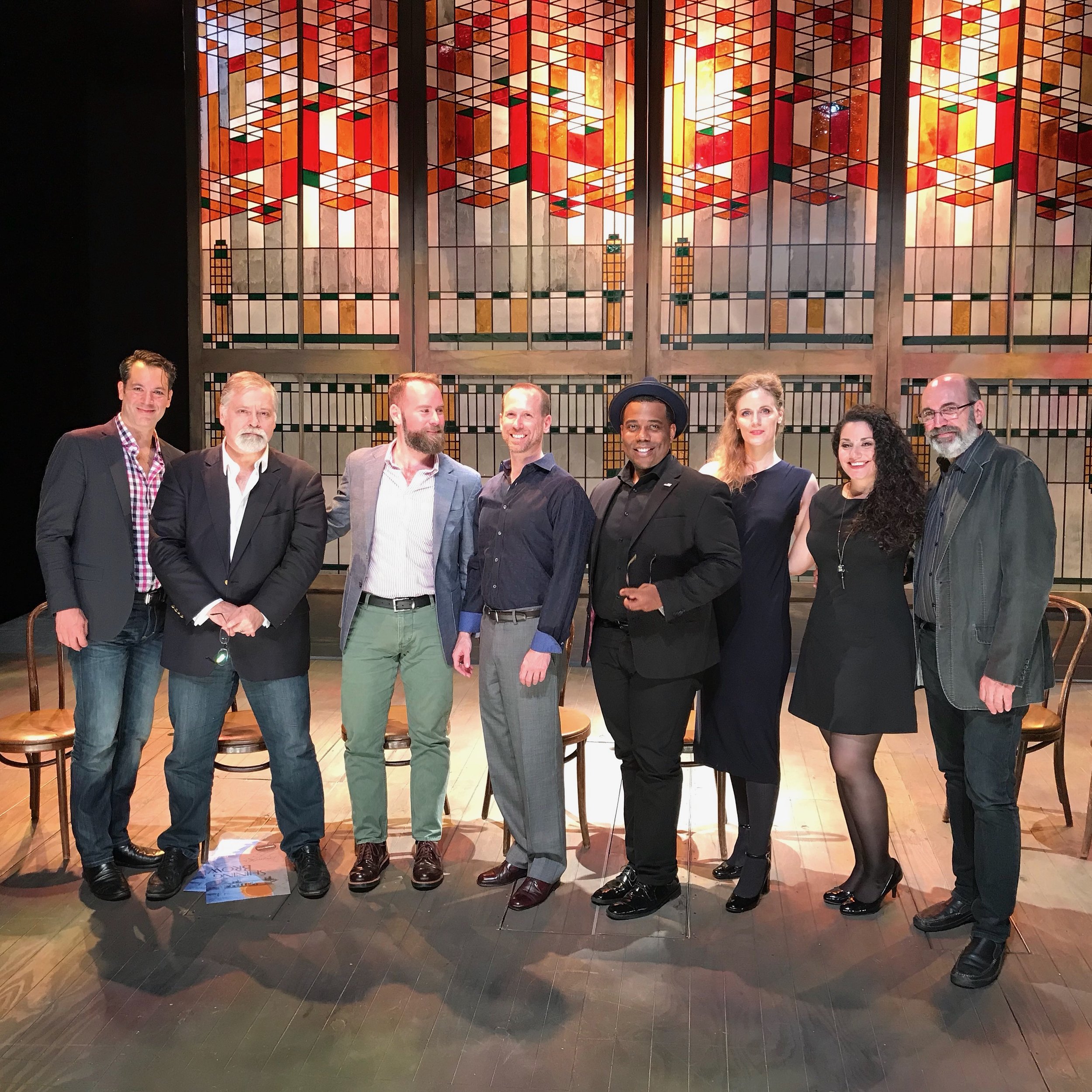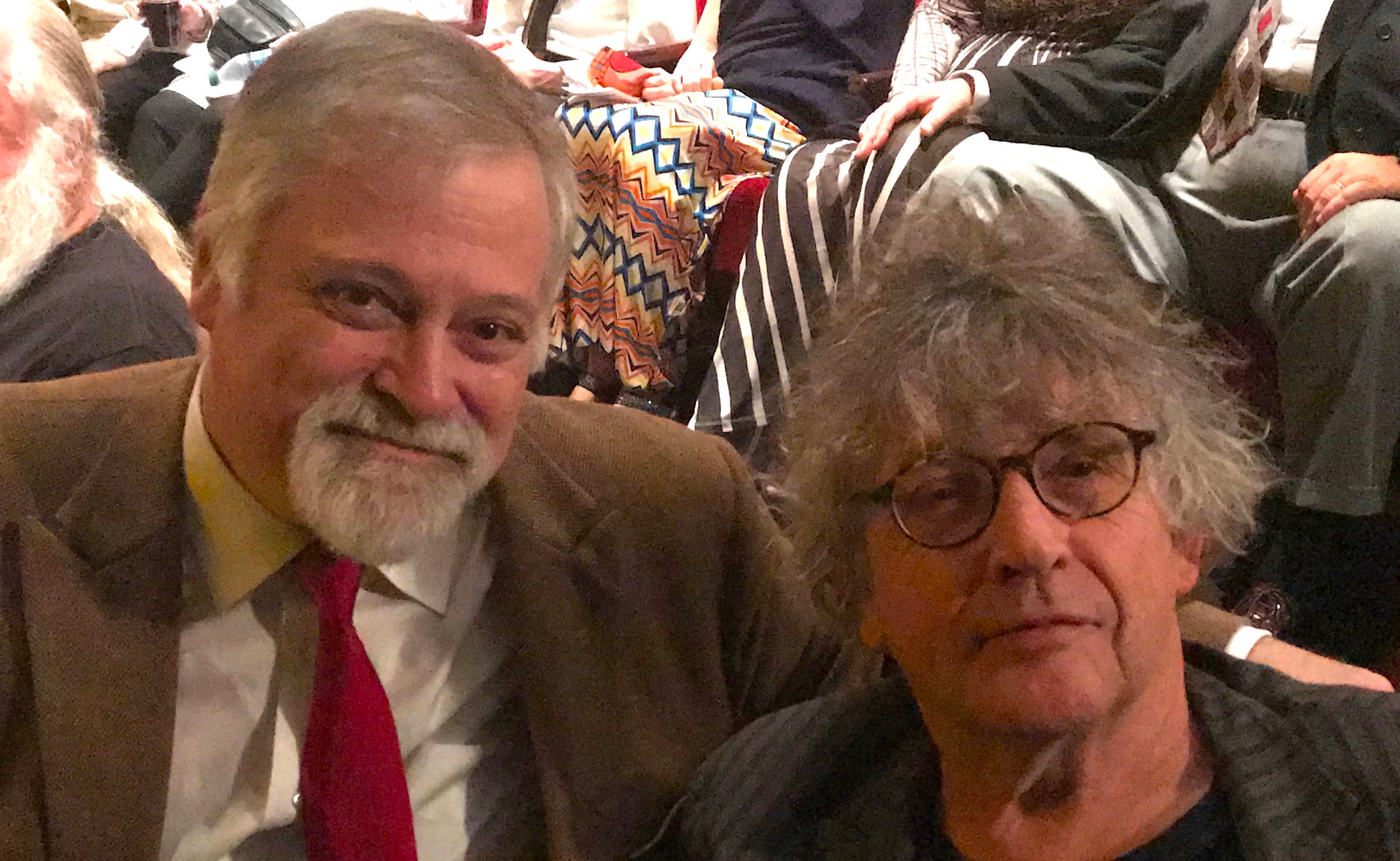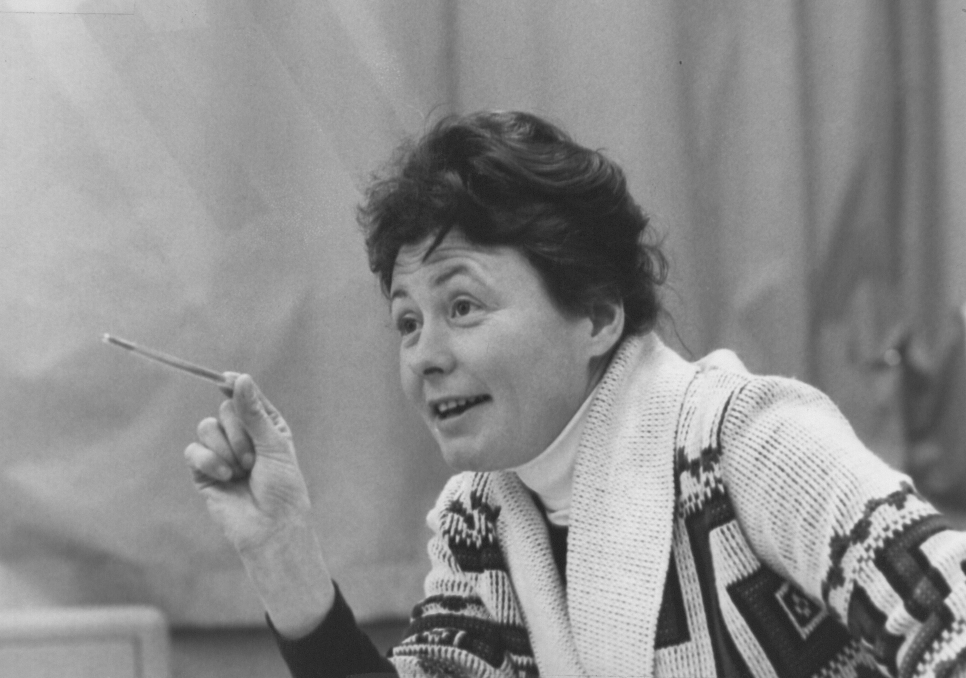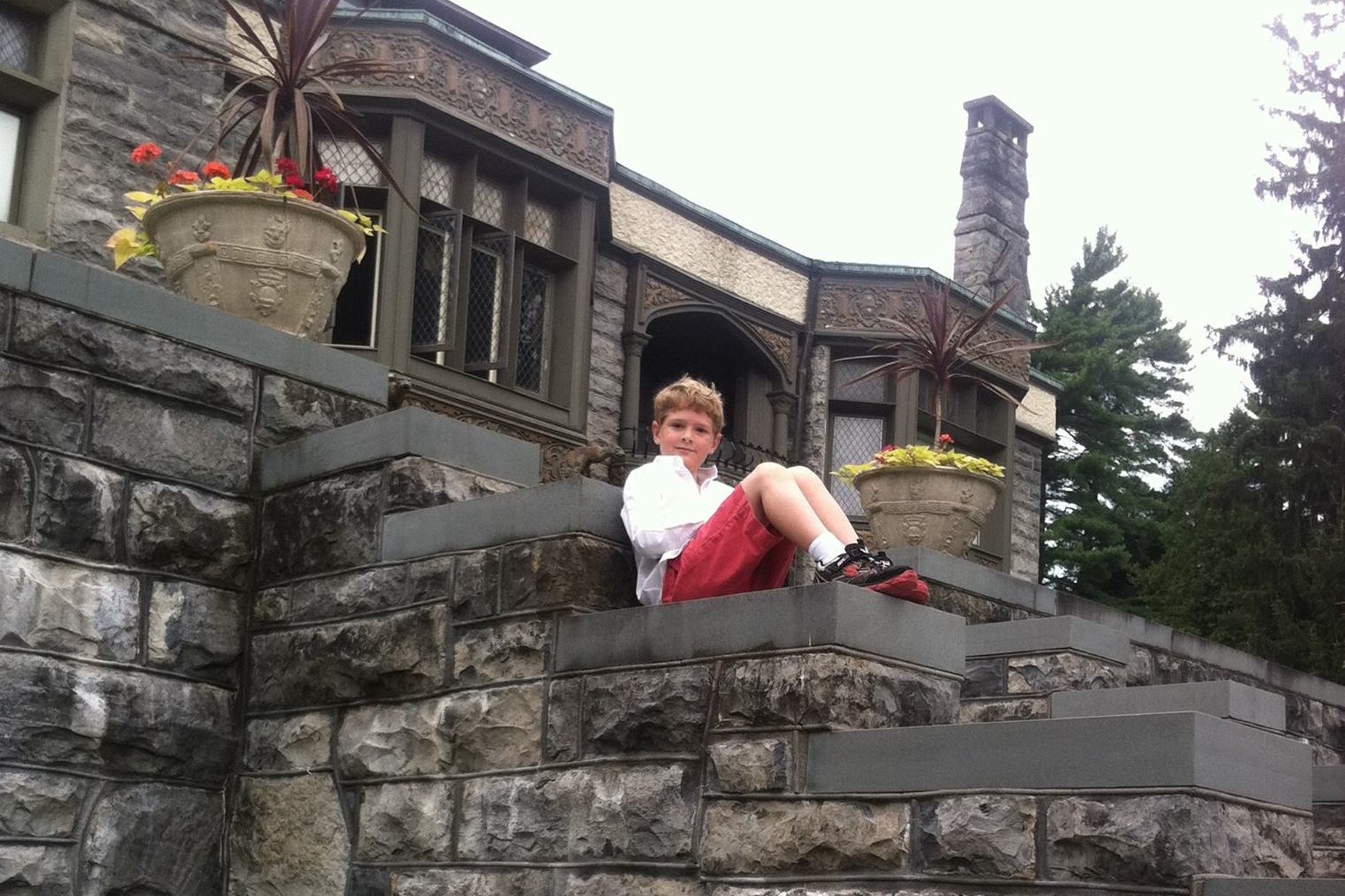David Leo Diamond (July 9, 1915 – June 13, 2005) was an American concert music composer and one of America's great mid-century symphonists. He was also my teacher. He was tough on me, and often cruel, but I always felt that he believed in me, and wanted me to be a better person and artist than I was. He had known the best minds and talents of his time, and I relished the challenge his aesthetic and intellectual expectations represented. Over the course of many years, I think that I grew to understand him. By the time that he died, I think that we had become friends.
###
“Yes,” I read the letter, astonished and trembling in our rural Wisconsin kitchen in 1978, “your son is the Real Thing, a born composer. I think he should come to New York and study at Juilliard with my friend David Diamond.” It was from no less than Leonard Bernstein, to whom my mother had sent some of my music with a plea for guidance. Astonished, mother sent this man Diamond, of whom we had never heard, a letter. He wrote back to her, “Helen Coates did deliver your son’s score to Mr. Bernstein and Mr. Bernstein sent it on to me here with his reactions which were enthusiastic. He clearly feels your son should study with me here [at Juilliard]. … Above all, though, the composition jury will need much more music to consider.”
David Diamond studied at the Eastman School with Bernard Rogers, in New York with Roger Sessions and in France with Nadia Boulanger; while living in Paris, he also befriended Andre Gide, Albert Roussel, Maurice Ravel, and Igor Stravinsky. He was a superb artisan whose Neo-classic compositions grafted intense lyricism with a neurotic and deeply felt hyper-contrapuntal compositional style. He became a star in the compositional firmament quite young, and spent the rest of his career beguiling and reviling performers and colleagues.
Bernstein famously referred to him as “a vital branch in the stream of American music,” while Virgil Thomson (for whom—like Ned Rorem, like me—David briefly worked) wrote, “Composers, like pearls, are of three chief sorts, real, artificial and cultured. David Diamond is unquestionably of the first sort; his talent and his sincerity have never been doubted by his hearers, by his critics, or by his composer colleagues.” Posterity was important to him: he left behind meticulously crafted ballets, eleven symphonies, concertos, ten string quartets, numerous chamber works, and many admirable songs.
But I knew none of this then.
I also wrote at that time to Lukas Foss, John Harbison, and Dominick Argento and asked each for guidance. All three wrote kindly letters advising me to enroll in Madison for a year. I wrote to Diamond that I had decided on Wisconsin for a year, at least, before coming to the coast. After admonishing me for not putting my return address on the envelope of the letter, he concluded, “If you have been accepted into the Wisconsin school by all means go there and see how you fare. … Make your application next year.”
I enrolled at the University of Wisconsin-Madison. The next winter, I sent some more music to Diamond. His response was brutal:
“Certainly, I hope you will make a good impression in all the entrance exams required. After all, Mr. Bernstein’s recommendation to me matters, but it will not matter that much to the jury unless they agree. I say your potential is large. But you are very young and art is very long, and it takes many years, even decades to develop a strong technique, an individual style. As of now I sense enormous facility, no interesting thematic ideas, and little self-criticism. So you see, there is the goal to set for real achievement in a very difficult art form. And I am willing to help you reach that goal. So let us hope for good results from the jury, the exams, the Deans.”
Demoralized, I applied to Juilliard as instructed. My parents fought bitterly over whether to spend the money on the airplane ticket, Father capitulating only when Mother said, “If he is turned down, then maybe it will convince him to go to law school the way you want him to.”
I arrived at Juilliard preceded by my scores and a mediocre letter of recommendation (I steamed it open) from my composition teacher in Madison that read, in part: “Daron’s music operates within a narrow and highly derivative framework excused perhaps by his inexperience and youth.”
It was evident to me the moment I entered the room that I was to be sent packing. The men who were to determine my future—Diamond, Elliott Carter, Milton Babbitt, and Vincent Persichetti—sat at a long table on one side of the room. I seated myself in a straight-backed chair on the other side, facing them. The scores I had submitted sat in a neat pile in front of Diamond.
“Lenny wrote to me about this young man,” began Diamond. A flicker of interest—or annoyance—flitted across Babbitt’s face. “Why do you want to be a composer?” asked Persichetti. “Because,” I replied, “it is the only thing I have ever done that I know I will never be as good at as I want to be.” My bravado met with cool disapproval. Diamond moved to the piano and, moving from low to high, stabbed at six or seven pitches. “Kindly sing the pitches back and name them,” he said. I started to sweat as I sang the first three or four and then trailed off. “Your ear is not your strong suit,” he clucked.
Next, Persichetti moved to the piano. “I am going to play a little medley for you of various themes. Just call out the name of each, if you can, as I play, and I’ll move on to another.” I recognized the unmistakable pungency of the Tristan progression.
“Good,” he smiled warmly. I was dazzled as he seguéd directly into a Gershwin tune whose name I didn’t recall, “That’s fine,” he said, continuing. Then I missed two, and he played something that was clearly Mozart, but what I didn’t know. I tittered nervously. “What’s that?” asked Persichetti. “I’ve never seen someone do that before,” I effused. “That was wonderful!”
“Yes, well,” said Diamond. “Evidently the repertoire is not your strong suit either.” Carter looked out the window. Babbitt looked at the table in front of him. Neither made eye contact with me or said a word. Diamond reached for one of my scores and flipped it open. After paging through it idly, he pushed it over to Babbitt, who didn’t look at it. “Mr. Hagen,” said Diamond funereally, “it is felt that you should … return to Wisconsin and … develop your technique.”
Clammy with cold sweat in my Kermit-green leisure suit with a round-trip airplane ticket in the pocket, I thanked the men who had just passed judgment on me, excused myself, went to the nearest bathroom, and vomited. Seated on the toilet, I wept with humiliation, fury, and frustration. They had been clear: I was not good enough. I returned to Wisconsin a day early. My parents, who didn't know that I'd be arriving that night, were asleep when I got home.
I returned to Madison, and began lessons with Homer Lambrecht. I also practiced the piano and composed obsessively. I took a flier and applied to the Curtis Institute, and was invited by Ned Rorem to study with him there. Over the course of three years there, I composed “one of everything”—nine hours’ worth of music (three hours worth was symphonic), and either performed it myself, or coached and conducted it.
“I am writing to you,” I began in my letter to David in January 1984, “because I feel I’m finally ready to come to Juilliard. Studying with Mr. Rorem has been a revelation, but,” I wrote, telling him exactly what I knew he would want to hear from a potential student, “I realize that my facility can still get ahead of my self-criticism and honestly feel that you are the single best man to help me with that.”
Did I really believe that David was the right teacher for me? I don’t think that I cared. I intended to move to New York, and I needed a place to hang my hat. When I told Ned that I wanted to finish my training with David, he looked alarmed, “Are you sure? What makes you think you’re not ready to just go out and start?” I told myself then that learning from David’s command of large-scale forms (symphonies, string quartets) would perfectly compliment the grounding I had received from Ned by way of his virtuosity in small ones (song cycles, suites). It turned out to be true.
March is the month that most conservatories hold auditions. Juilliard was no different. On the way to the interview, I passed the bathroom in which five years earlier I had vomited. The door opened, and David, in a zippy blue pin stripe suit, poked his head out. Rain fell straight down. I straightened my tie, shot my cuffs, and sidled past him, into the room. I scanned the table set up before the windows, through which the Hudson could be seen like a gray stain, and recognized Babbitt, Carter, and Persichetti.
“Mr. Hagen,” he drawled. His thin lips and pale face were dour, but his eyes shone. “You may sit down.” So serious! I stripped off my raincoat and dropped the copies of the New Yorker I’d brought to catch up on during the train ride from Philly. They slid to the floor. I flapped my arms.
“Oh, for the love-a Mike!” I hissed. I looked up into Persichetti’s kind eyes. He had been trying to see what I was reading. “Hello, Mr. Car—,” I said, lunging at him. “No, he’s Roger Sessions,” piped Babbitt. “That’s not funny, Milton,” scolded Diamond. My head swiveled to respond. I opened my mouth like a koi. “We all remember you from four years ago, Mr. Hagen. And, looking at the number of scores you’ve sent us …well … it seems as though you have been working very … hard.” Diamond offered the observation as a question, his eyebrows rising. “You’ve been very … prolific … haven’t you?”
I returned his gaze steadily as he fingered the American Academy of Arts and Letters pin in his lapel. Was it a trick question? This time, telephone conversations had been had, arrangements been made: Ned had spoken with Bernstein, and with Diamond. I had made hay at Curtis, acquired some connections, and managed a couple of minor achievements. Was Diamond inferring that I had been too prolific? Shrugging, I looked out the window at the Hudson River over the roof of the LaGuardia High School. Through the gauze of rain, I could see the sun setting. There were gulls.
“Let’s see,” Diamond continued. “Vincent, will you do the honors?” Persichetti stubbed out his cigarette, scrunched his eyes up behind his glasses, and slid onto the piano bench. He winked at me. This time when he launched into his mad medley, I was ready for him: “Coronation Scene from Boris Godunov!” I said. An insane modulation and he was playing a Chopin Mazurka. “Chopin: don’t remember which one,” I said. He began the Tristan progression, and I said quickly, “Tristan, of course.”
“Nope,” he said. “Trick question.” He continued. “Of course, it’s Golliwog’s Cakewalk.” “Uh huh,” he smiled. He played one, unmistakable crunchy chord. “Rite of Spring!” I laughed. Something pointillist, lovely, but stylistically diffuse. “Pretty,” I mused. “I don’t recognize it.” He stopped. “Something of my own,” he smiled. “Neat!” I said.
“Mr. Hagen,” Diamond began, “I have no doubt whatsoever that you will be, or plan to be, as prolific as ever. I would say that is a blessing which must be haloed by the development of more severe self-criticism and a larger awareness of structural invention.”
I looked from one face to the next.
“Okay!” I said. “When do I start?” Laughter.
“Well,” said Carter, looking at me and speaking for the first time. “David will work out the details of your scholarship. That’s that.”
The following fall I began studies at Juilliard. To my way of thinking then, I was there for one reason: my composition lessons with David. I worked hard to please him. I thought that all of my peers were dynamic, impressive composers, but I instinctively kept to myself—so much so that many thought that I still lived in Philadelphia.
Every few weeks, the composition department held a composition seminar at which we either presented our new works, or a visiting composer presented theirs. The faculty attended, as well as all of one’s colleagues. I found the seminars desperately dry. After my first presentation, Diamond pulled me into the hallway and chewed me out: “Never, ever do that again. Your piece is brilliant. You are brilliant. What you said was brilliant. How you said it was unacceptable. You’re a better composer than most of the people in that room. If you don’t treat yourself with respect, how can you possibly expect your colleagues to?”
Like Witold Lutosławski, David wore excellently tailored suits. He occasionally rouged his cheeks. His shoes were always shined. He enjoyed sincere flattery. A serious drinker when he chose to be, he preferred very cold, very dry champagne and excellent vodka, if it was available, followed by brandy. David was fun to drink with. He enjoyed the fact that I could hold my liquor. He loved good food, arguments, and books. The pretentious infuriated him, though he seemed to appreciate people who could pull it off. It seemed to me that he felt that Society had short-changed him; it had contradicted his hopes. While his default mien was grave, he could be pixyish and ebullient.
Our every conversation ultimately circled back to the three intertwined things we had most in common: anger, depression, and chronic insomnia. Were the causes chemical, or the result of pathological narcissism? Were they darker, more Nixon-ian?
“When I was younger,” David told me once, “I rarely slept, always worried about money. My anger and my hostility drove me to extremes of behavior that must have seemed theatrical to some. Sessions, for example, when I confessed to him in a lesson that I intended to kill myself by jumping out of the balcony at Carnegie Hall, admonished me to jump from the second tier, as jumping from the first would leave me with broken legs, while the latter would guarantee a split skull, or at least a broken neck.”
A superb raconteur, David’s reminiscences of the 30s and 40s were peppered with vivid character sketches of Greta Garbo, Clifford Odets, Carson and Reeves McCullers, Copland, and Blitzstein, among others. A compulsive diarist, the shelves in his Rochester home contained dozens of books filled with his graceful, athletic handwriting. He confided to me over the years—usually in dark asides after some perceived slight—that he was writing an autobiography that would settle this or that person’s hash.
After David’s death, Gerard Schwarz, who genuinely loved him and continues to champion his music, loaned me a copy of an unpublished manuscript, which I read. I understand now why he chose never to complete it: the first fifty pages ring with his feisty voice, and promise a memoir as pleasurable and captivating as an evening spent drinking champagne with him, listening to him tilt at windmills, and lacerate colleagues. Sadly, the document loses its way, tells rather than shows, never progresses far beyond the 60s, and becomes a circular argument, exactly the sort of self-justifying document that David, as an avid and careful reader, disliked. Perhaps another, more polished, manuscript is out there somewhere, awaiting the hand of an experienced editor. I hope so: the world deserves to hear his version—whatever that may have been—of things.
David could transform in a heartbeat from needy to imperious. This made him numerous enemies. Not just his enemies questioned the accuracy of his memory. I believe that he tried hard to be truthful, but that he was more the Don than de Passamonte, more Pierrot than Pedrolino—in other words, the extraordinary intensity of his feelings (he was as ruthless with himself as he was with others) sometimes distorted the way he perceived not the truth, but the world.
Lessons could be grueling, especially if he had gotten it into his head that you had somehow betrayed him. I used to write music reviews for EAR, a downtown new music magazine. For a (rave) review of David’s Symphony No. 10 (premièred a few weeks earlier by Bernstein with the American Composers Orchestra), I had created what I thought was a pretty spicy lead: “Diamond’s Tenth looms over the audience like an enormous tombstone.” Someone had gotten a copy into David’s hands.
“You have a deep-seated subconscious desire to destroy me,” he bellowed. “Get out of my sight!” It was my first taste of his legendary temper. In my case, at least, it was always as fleet as it was quick. His apologies, when they did come, were always sincere. I admired him, and I always accepted them.
For Ned I composed three art songs each week for three years—one on a poem of my choice; one on a poem of his choice; one of a poem he had set. For David I constructed two fugues (each more elaborate than the last) a week for two years—one on a fugue subject of his choice, one on a subject of my own devising. Ned’s regimen helped me to learn how to access my emotions and express them fluently with musical notes. David’s regimen helped me to learn how to explore the relationship that those notes have with one another on the abstract, purely musical level.
David’s obsession with fugue as a compositional procedure mirrored his lifelong effort as an intellect to make sense of the world in which he lived. When Bernard Rands without malice wondered aloud during a composition seminar what the point of writing fugues was at the end of the twentieth century, David was apoplectic. Bernard was calling into question the very method by which David fashioned his sanity.
Inspired by the Copland-Sessions Concerts, I produced during those years several dozen recitals in Philadelphia and New York featuring my own, and colleagues’ music. I called them Perpetuum Mobile concerts because, at the time, constant movement was my way of life. My intentions were good, but I see now how naïve I was to have mounted them—particularly at my own expense. I wanted colleagues to like me, yes; and I thought that working together, we might all benefit professionally. I was genuinely surprised and hurt when several of the Juilliard composers whose music I featured treated me as though I was hitching my star to theirs. Diamond explained to me that I didn’t really care about other people; I just wanted to look as though I did:
“Daron,” David’s letter began, continuing a conversation begun a few days earlier on the telephone, “You are confused by my use of the word selfish. I refer to self-absorption, pre-occupation with self, self-advertisement, a certain exhibitionism and charm at the same time being generous in your Perpetuum Mobile concerts for young composers is not the inner you, it’s the outer man saying, “look gang, I’m for the other young’uns.’ Giving in this way is not altruism of the spirit."
###
“Fugue subjects,” David said, briskly sketching one on the sheet of music paper on the piano rack in front of us on a winter morning in 1986, “are like snakes.” Over his shoulder, I could see snowflakes whirling outside through a tall sliver of one of Juilliard’s slit-like windows. “Every one of them has a head, a body, and a tail.” Chop, he slashed a line between the head and the body. Chop, he slashed another between the body and the tail. “Or like people,” I replied, “with a head, a body, and a tale.” He laughed pleasantly. The Regency Theater just around the corner was in the middle of its three week Truffaut retrospective; Marc Blitzstein’s Piano Concerto had just been performed at Carnegie Hall for the first time in fifty years.
“Or a Life,” he frowned, leaning over the keyboard, “with a memorable Beginning, Middle ripe for development, and an End….” He stopped writing and straightened up. “Now sketch a counter-subject.” I took the pencil from him and began adding my squiggles to the line above his. He pursed his lips. A sharp intake of breath: “Something memorable,” he said, “not ... mechanical.” I tried again, but all I could think was that Life, like “a Pretty Girl, is like a Melody.”
I looked at the oil of Pierrot he had painted that hung over the piano. It wasn’t very good. Clowns frighten me. I giggled nervously. “What’s so funny?” he asked. “If Life is a Melody, then Energy must be the human compulsion to organize sound into Song,” I rallied, half-serious.
“And Force is the application of creative energy,” he smiled encouragingly. “And composition is Birth?” I asked. “And pulse is Gravity,” he answered. “Which makes entropy, or the lack of pulse, Death,” he said, taking the pencil. “Look,” he circled the head of my counter-subject, “this is memorable, so why not just take the tail of the subject, invert it, and use that as the head of the counter-subject?”
Chop, I thought: the snake devouring its tail. Chop. “In my beginning is my end. Eliot,” I risked. He chuckled. “Right. The Ouroborus. My end is my beginning. Mary, Queen of the Scots. Earlier. Better,” he replied with finality as through the door the three light knocks of his next student indicated that my lesson was nearly up. I carefully placed the enormous pages of my manuscript into the elephant portfolio in which I had brought it.
It took me twenty-six years to understand what David said next: “Mr. Hagen—,” he admonished gravely as I reached for the doorknob. I turned around, and his voice softened. “Dear One,” he began again, “Don’t let gravity win.”
###
As inspiring as studying composition with David was, dealing with him as an employer was an exercise in sadism. I copied the parts for his Flute Concerto, commissioned by the New Haven Symphony for Jean Pierre Rampal. Rampal, while in every other way professional, urbane, and musically sublime, had been too busy to learn his part before the first rehearsal. As copyist, I was compelled to attend rehearsals and to correct any errors that might need fixing. It was snowy and nasty that week, and I disliked intensely the train ride from New York to New Haven. (I did manage to compose a Suite for Viola during them—so at least I have that to show for the commute.) Murry Sidlin vented his frustration when three or four errors that had eluded my proofreader’s eye became known piecemeal because the orchestra, in order to save money, had excused certain players until the last minute.
I recall standing at the lip of the stage score in hand. David sat in the audience, my former lover seated beside him. Wheeling around and pointing at me from the podium, Sidlin shrieked, “Copyist! I thought you corrected these parts!” It was the copyist’s and the composer’s worst nightmare. Humiliated as a man and as a copyist, I answered, “I’ll correct them during the break, Maestro. “What?” bellowed Sidlin. “The break,” I said. “During the break.” Sidlin writhed with frustration. I looked at Rampal. Holding his flute like a scepter, he stared out into the empty hall. I looked at my former lover. I looked at David, who appeared to know a whole lot more about what was going on than I did.
After the premiere, I accepted an invitation to join Rampal, my ex, and David for a late dinner. I found it impossible (as, flirting with the waitress, he drew an American Express Black Card from his jacket pocket as fluidly as one would a handkerchief from one’s sleeve) to dislike Rampal. Feeling like a spider caught in a web, I drank. A kindly Yale coed took me home with her. Back in New York, David commanded me to make corrections to every one of the seventy or so printed parts by hand, using whiteout, India ink, and an electric easer. I suppose he thought he was teaching me a lesson.
Not long after, at my final lesson, he said, after observing that I had never brought him a vocal piece to look at, “I was speaking to Lenny the other night about you. He says that it’s a shame that you never showed me your vocal music, because I could have cleaned up your prosody problems.” I was astonished. A year later, at my first lesson with Bernstein, I was saddened but not surprised when he told me that he had never said that.
The school year ended, and with it my time as a student of David’s. A colleague threw a party at his stylish Lincoln Center apartment. My colleague—David’s favorite student—was handsome, ambitious, intelligent, blandly elitist, and highly accomplished. Diamond adored him, and called him, as he called me, “Genius Boy.” I admired his craftsmanship and work ethic. His bookshelves were stocked with well-thumbed volumes. Good literature, in good editions. One wall was covered floor-to-ceiling with orchestral scores. A gifted pianist, his grand piano dominated the living room. Tasteful objets d’art were carefully placed here and there. An inscribed portrait of Diamond hung between the bedroom and bathroom.
The liquor was expensive. The conversation was interesting. The fond farewells to David were sincere. He’d be stepping off the Juilliard faculty in a few weeks, and this party was both a birthday celebration and a sendoff. Supine on the couch, vodka martini cradled on his chest, David held forth about Ravel’s L’Enfant et les sortilèges to a ring of attentive upturned faces. I poured a scotch. Seen through the heavy tumbler, the tableaux looked like a Caravaggio. Uneasy, I put the glass down without drinking from it.
Virgil Thomson called what I did as a copyist to make money “working on other men’s music,” and fiercely disapproved—except when I worked for him. Vincent had only recently told me to do anything but. Scholarship notwithstanding, I was self-supporting, and I needed the dough. I fingered the frayed cuff of my Brooks Brothers shirt, knew the lining of my jacket had long since begun to sag, took note of my scuffed, cheap shoes, and remembered that I was broke.
I had been taught at the back of Father’s hand to never, ever, ever give the impression that I thought highly of myself. Indeed, I thought of myself with my ass in the air in my pajamas at the age of seven along with my brothers, scrubbing the kitchen floor in the middle of the night, Father hissing, “You all think you’re smarter than me.”
I gave David a letter, and left.
For the next few weeks I copied music in order to make some money on which to live while composing at an artist colony. July rolled around. I put my books and papers into storage, gave away the furniture, and hit the road again, my knapsack on my back. On my way out of New York, I checked the mail one last time and found a letter from David:
“I have read the very touching letter you gave me on leaving [the] party several times and treasure the feelings expressed in it. It is good to know that I have contributed something of value to you as a teacher during your Juilliard years.”
I still had a year of studies to complete at Juilliard. I met with Joe Polisi, who told me that I would work for a semester each with Joseph Schwantner and Bernard Rands. This seemed both interesting and agreeable. Consequently, in between fulfilling commissions and working as a freelance pianist and copyist, almost by accident, I completed the coursework for the masters’ degree. As it had become time to discuss whether I would remain to pursue my “terminal degree,” I was summoned to the same room in which I had first auditioned. Diamond, Babbitt, and Persichetti were already there. They sat in a row on the other side of the room. It was hot for June, but a familiar icy remoteness gripped me. I became hyper-aware of my surroundings. When we met seven years previous, I was an annoyance to them, a fly that deserved to be swatted—no, flicked—back to Wisconsin. I remembered the ridiculous green leisure suit I'd worn to that audition. This time I wore a Juilliard sweatshirt and blue jeans. I had a clear idea of where I stood, professionally. Now I was competing with them for commissions.
During their lifetimes, composition programs had sprung up around the country; the doctorate (which had barely existed in composition) had become an exclusionary degree: if one wanted the financial safety net of a career in Academe, one now had to have one. I smiled at David, who was scheduled to return to the faculty. He gave me a schoolmarmish scowl in return, and began, “Despite my objections, Daron, you have continued to accept commissions while engaged in your studies here at Juilliard. You produce concerts, you accompany dance classes, you copy music, you conduct a chorus at NYU, and every time I talk to you you have a new amour. I think that you should take a year or two off to consider your life choices before returning to complete your degree. Perhaps then you’ll be prepared to concentrate on your composing in a more disciplined fashion.”
“You need to decide,” David decreed, “what is really important to you.” At that moment, he reminded me of my high school trigonometry teacher Max Hilmer, sincerely baffled that I didn't want to be like him. I thought also of Diane Doerfler, the literature teacher who had taught me that “making art is more important than teaching about it.” Finally, I thought of Ned Rorem, who had once mistakenly mischaracterized my fear of being thrown out of school as “a seething desire to please” him. I felt as though David was trying to manipulate me, and life with my mercurial, emotionally-manipulative father had taught me to become emotionless (that familiar icy remoteness), and capable of brutality when I felt that I was being subjected to manipulation. Oh, I was seething now, all right, but not with a “desire to please.” You spend your time, I thought, or you are spent.
“May I have some time to think about this?” I asked. He became suddenly magnanimous: “By all means, Daron. Take as much time as you need to decide.” He clapped his hands together and then spread them before him like a blackjack dealer completing his shift. I smiled coolly in return, excused myself, and walked as slowly as possible to the door. Closing it with elaborate care behind me, I looked across the hallway at the door of the bathroom in which I had thrown up before retreating to Wisconsin. I walked briskly to the elevators. As I jabbed the call button, the remoteness dissipated, a sheen of cold perspiration slicked my forehead, and I began to feel again.
With a ping, the doors parted, revealing a flock of ballerinas in leotards clutching diet Pepsis and wadded-up packs of cigarettes. I took a deep breath, held it, and plunged into their midst. They unselfconsciously banged into one another and brushed up against me. I got an erection. Their voices piled atop one another like flamingos. I exhaled explosively. Their long pink necks and sweaty, gangling frames generated a miasma of musty leggings, baby powder, crotch, and cigarette-smoke. There was no air.
I felt hot. Then I felt cold. I poked at the first floor button, three, four, five times. My ears began buzzing; my reflection in the doors began to blur. I was going to pass out. I looked around at their rouged baby-faces and their hard eyes. My hands turned to ice. Another ping. Just in time. I tumbled out into the Juilliard lobby and down the stone-lined tunnel of the entranceway across from the (then) Chinese consulate on 67th Street.
I needed to sit. Looking for a bench, I saw my ear-training teacher, Mary Anthony Cox. As I passed her, she noted my distress and indicated that I should join her. I admired and trusted Mary Anthony. She was one of the best teachers I had ever had. She asked what was wrong. I put my hands out before me, palms down, and watched them gradually cease trembling. Then, I described my meeting with the composition faculty.
“Honey,” she sighed, “you are a round peg. Graduate school is a square hole. Of course you can make yourself fit in here, but you don’t belong. You’re a real composer. You write music. So, do it. Mozart didn’t need a doctorate to write his operas. You don’t need one to write yours.”
###
Over the course of the next seventeen years, I made semi-annual visits to David at his home on Edgerton Street in Rochester. He never forgave me for not finishing the doctorate at Juilliard. “Twenty years from now,” he predicted, “you’ll need it. Tastes change. People forget who you are, what you’ve accomplished. A new generation denies you respect. It has always been that way.” I called him once a month to visit, to ask how he was, to gossip, and to ask him what he was working on. At one point, he asked me to orchestrate his opera The Noblest Game for City Opera, as he no longer had the physical stamina to execute it himself. (I begged off.) As the years passed and I remained staunchly supportive, grateful, and respectful, our correspondence took on a gentle mellowness punctuated by his flashes of caustic commentary on each emergent compositional saveur du mois. I learned only after he died that I was the one of the few of his numerous students to remain steadily in touch with him. In May 2005 I wrote to David:
“On the telephone just now you asked me why, after 26 years, I continue to write so much music. I think that I finally have an answer for you. I write music compulsively, reflexively. How could you expect me to slow down or to stop any more than you could expect LB to settle down and to focus his energies on composing? I write so much because I write when I’m sad, and when I’m happy, married or divorced; when I’m broke, and (even better, I’d like to believe) when I’m flush. I compose whether I’m paid to or not, and whether I want to or not. I compose as I always have done: as I breathe—because the alternative, cher maître, is unacceptable. …So please do come to Yaddo [the artists’ retreat in Saratoga Springs, NY] next month, where Michael Boriskin and I have put together a concert that will be performed in the Music Room at Elaina Richardson’s behest that will feature your early Flute Quartet. I miss you and long to see you.”
The late afternoon light on the main lawn of Yaddo in June was stunning. David and I stood on the back patio, arm in arm, looking down towards the Sleepy Naiad statue at the foot of the lawn. He had grown frail. “Before I forget,” he said, “I want to tell you that Marc [Blitzstein] used to like to sit over there.” He squeezed my hand and pointed at a spot far down the lawn near the rose garden. We turned around, and re-entered the grand hall. I guided him gently into the Music Room. Life-sized full body portraits of the Trask children loomed over us like gravestones. Late afternoon light streamed laterally through the leaded windows.
I looked at David: his impeccably tailored gray serge suit hung loosely over his diminished frame. His blue shirt’s collar was crisp. There was a large New Zealand-shaped liver spot on his scalp over his right eye. What remained of his hair was colorless. His skin was papery and luminous. His rheumy eyes brimmed with tears.
“Marc cared,” he whispered urgently. “When he wrote Regina here, he could sing and play every note. He knew words. You remember I told you once that he rewrote the entire libretto for Lenny's Trouble in Tahiti without needing to change a note of the music?”
I stood up, walked to the front of the little ensemble, and addressed the audience. Comprised almost entirely of local high school students enjoying a rare glimpse of the estate’s inner sanctum, they were attentive and excited. “A word about teachers,” I began my memorized introduction. “I have been a member of the corporation here for a number of years, am in the middle of my career as a professional composer, and have addressed many audiences and classrooms filled with students. It has been twenty years since I had a lesson with the amazing man sitting a few feet from me. Nevertheless, I am more nervous now speaking in front of him than I have been before any audience in the interim. Teachers that we admire and adore have that effect on us. That’s a good thing.” There was a sprinkle of laughter. I asked the audience to acknowledge David and they applauded warmly.
“Thank you, Dear One,” he said, sitting. “You know, I can actually see them all around us: Lenny, Aaron, Virgil, and Marc.” He meant it. More tears.
The concert over, I asked my wife Gilda to snap a few pictures of us.
“I think that it is an illusion that the dead have left us, David,” I ventured, as we posed. He smiled, squeezed my hand, and whispered, “Yes.” “How are you?” I asked. “Terrible. My heart, you know.” “But Jerry is doing your music.” “Yes, but he’s the only one.” We sat together for a few minutes. “They're all here, Daron,” he said, with conviction, “especially at Yaddo.” And then, voice trailing off, “I’ve driven so many people away; I’ve lost so many….”
At that moment, a dozen schoolchildren from the audience surrounded us. They had loved his piece. He smiled radiantly, sincerely enjoying the moment; he accepted their praise, and asked them their names.
A few days later, on 13 June 2005, David died of heart failure.
This essay has appeared in the Huffington Post. You can read it there by clicking here.




